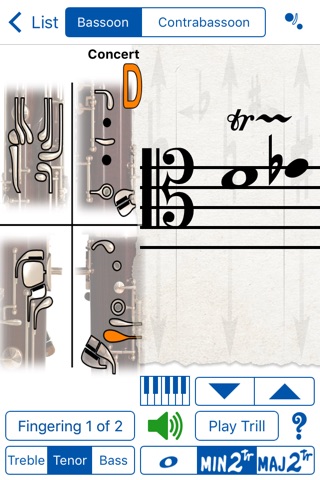
Fingering Woodwinds for iPhone app for iPhone and iPad
Developer: Patrick Q. Kelly
First release : 04 Jun 2010
App size: 102.82 Mb
Immediate access to fingerings (with alternates and trills) for each instrument’s entire playable range. Get fingerings from the written or concert pitch.
Instruments: Piccolo, Concert, Alto and Bass Flutes, Oboe and Cor Anglais, Soprano, Alto, Bass and Contrabass Clarinets, Bassoon and Contrabassoon, Soprano, Alto, Tenor and Baritone Saxophones
The Piano instrument simultaneously displays the note names, the locations on the piano, and the musical notations of up to 5 pitches in either Treble, Alto, Tenor or Bass clef. The Notation can be transposed for most all instrumental transpositions.
• All woodwinds have trill fingerings for minor 2nd and major 2nd intervals.
• Flutes and Saxophones have additional fingerings for minor 3rd and major 3rd trills.
• Alto and Tenor Sax include altissimo fingerings up to written F, two octaves above the top line F of the treble clef.
• All Woodwinds include visual guides to the key names and locations on the instrument to understand the fingering charts better.
• Bassoon and Contrabassoon include Treble, Tenor and Bass clefs.
How to Use:
Pick a written note (touch the staff) and have the fingering displayed and concert pitch played. Touch a button and reveal the note on the piano.
Play a concert pitch on the piano, and have that pitchs fingering displayed. Touch a button and reveal the transposed note written on the staff.
• If there are alternate fingerings available for a note or trill, a button will allow you to navigate through them.
• Use the Play Note or Play Trill button to repeatedly hear whats being displayed.
• Use the mute button to access the fingerings without hearing the pitches.
Selecting a Pitch:
Using the Staff (transposed for the current instrument): Simply touch and slide up and down on the staff to select the note, slide to the right or left of the note for sharps and flats.
Using the Piano (concert pitch): drag in the area below the keyboard to move the keyboard, touch to play notes, touch & slide to change the pitch. When you glissando up the keyboard, notes will be notated as a raised value (sharps), when you glissando down, notes will be notated as lowered values (flats).
Use the up and down arrows to move chromatically up and down without touching the music staff or piano keyboard.



